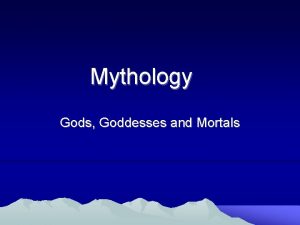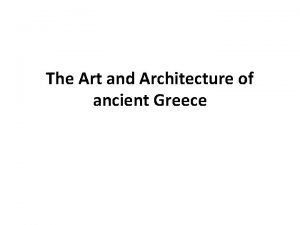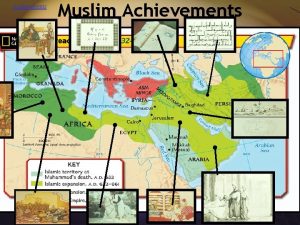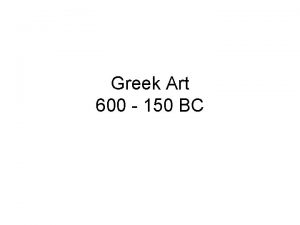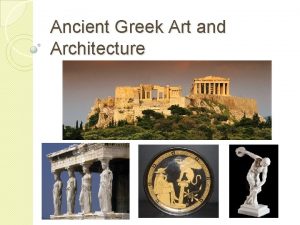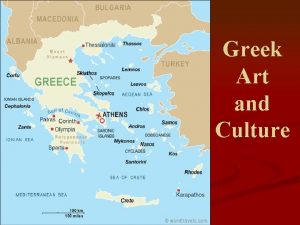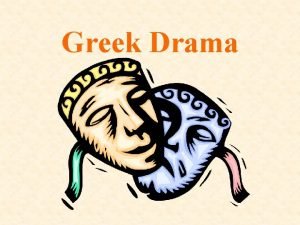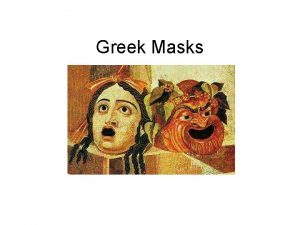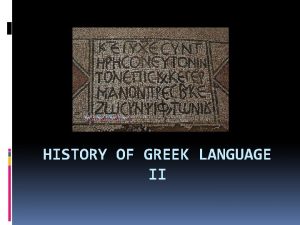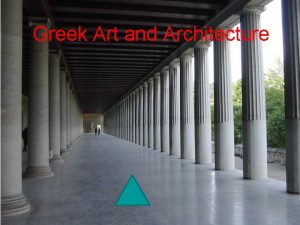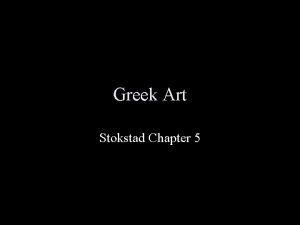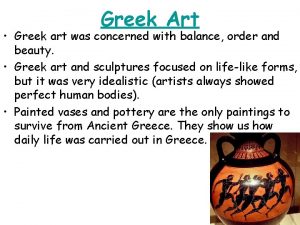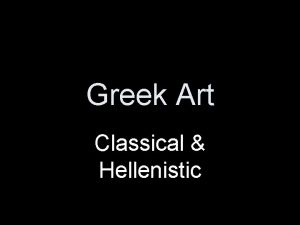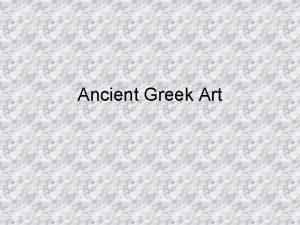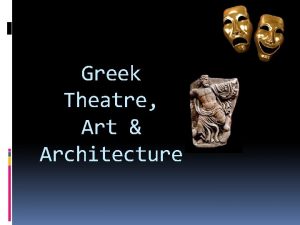GREEK ACHIEVEMENTS ART AND ARCHITECTURE The history of































- Slides: 31

GREEK ACHIEVEMENTS

ART AND ARCHITECTURE The history of ancient Greece is filled with Greek figures, or important people, who made enduring contributions in the arts and sciences. In architecture, for example, Pericles directed architects and builders to create many beautiful structures. People use these same designs for modern buildings. In the center of the Acropolis of Athens, Pericles oversaw the building of a magnificent temple, the Parthenon, which honored the goddess Athena. Completed in 438 B. C. , the Parthenon took 9 years to build and required more than 22, 000 tons of white marble. Its architecture expresses balance and simplicity, qualities valued by the Greeks. Many modern buildings, such as the United States Supreme Court Building in Washington D. C. , use designs based on the architecture of Greek temples. Statues of Greek gods and of people decorated Greek buildings, both inside and outside. Never before had statues been created to look so lifelike myths. Greek painters took the same care to portray people and scenes from Athens’ history and from Greek Paintings on ancient vases provide evidence of the skill of Greek artists. Using black or red paint, artists decorated the vases with sciences from Greek mythology and from their own daily life. By carefully observing these vases, we can see how people dressed, how they wore their hair, and even what they ate.


The Diskobolos Hermes of Praxiteles

Venus de Milo Winged Victory of Samothrace

Laocoön and His Sons

“Black Figure pottery is one of the most recognizable Greek pottery designs emerged. Black figure pottery bears iconic representations of figures from Greek mythology. The mainly black figures are more intricate than mere silhouettes, with facial features, clothing and weaponry depicted in reds and yellows. Zeus, Achilles, Athena and other gods and mythological figures adorn the pots from this period. “ (ancientgreece. com) The Amphipolis Mosaic The Mask of Agamemnon Vatican Amphora by Exekias

ARCHITECTURE Ancient Greeks took pride in decorating their temples for their gods and goddesses. They developed three types of orders (or columns).

LITERATURE AND THEATER Ancient Greek writers left a treasure chest literature, which included new styles of writing. They created the foundation for literature in many later Western culture. Even today, Greek literature permeates our literature and language. In the 700’s B. C. , one of the earliest Greek epic poets, Hesiod, wrote down the myths and legends that had long been told in Greek mythology. In other poems, Hesiod described the difficulties everyday life in ancient Greece. His poems have provided modern historian with useful information about early Greek culture. Homer’s Iliad and Odyssey became the later Roman culture’s first literature. The main themes of the Odyssey—adventure and returning home—continue to be used in literature as well as in movies. The stories of Aesop’s Fable still teach moral lessons to children and adult alike. Among Aesop’s bestknown fables are “The Shepherd Boy and the Wolf” and “The Hare and the Tortoise. ” Many words in the English language come Greek literature. For example, we call a book of maps atlas, after the Greek god Atlas was said to carry on his shoulders the columns that separated the heavens and the earth. Another example is the saying Achille’s heel, which is sometimes used to describe a person’s weak spot. It comes from myth about Achilles, a Greek hero of the Trojan War.

Hesiod


LITERATURE AND THEATER Through theater, plays became an important part of Greek literature, Even the word that means “a place to see. ” During the Golden Ages, Athens was known throughout Greece for its fine theaters and skilled playwrights was Sophocles, whose works are still performed today. Sophocles’ plays in which the main characters come to an unhappy end. In Sophocles’ tragedies, heroes always struggle to do the right thing. In one play, a young woman named Antigone faces a terrible choice. If she chooses to do the right thing, she will break an unfair law. The punishment for breaking the law is death. Antigone chooses to do the right thing and accepts the consequences. By contrast, Greek comedies always end happily for the main characters. A comedy is a humorous play, and Greek comedies often poke fun at people and ideas. Aristophanes was the master of Greek comedies. In his comedies, he used humor to make serious statements about political and social life. Greek theater was different from theater today. First, a trip to theater in ancient times was an all -day outdoor event. Also, only men could appear on stage, so men had to play women’s roles. Since the cast often included only a few people, the actors took on many different parts. This fact made costumes important. All actors wore masks designed to represent different characters and emotions. Theater in the Golden Age was a place for both popular entertainment and ideas. Plays dealt with issues ranging from political and religious conflicts to problems of everyday life. Since every generation faces issues such as these, Greek plays continue to influence our literature.

Sophocles

SCIENCE, MATHEMATICS, AND HISTORY Even before the Golden Age of Athens, the Greeks had begun questioning old ways of thinking. Their ideas led to the dawn of rational, or logical thought in science, mathematics, history, and philosophy. Some ancient Greek thinkers doubted that gods and goddesses caused events in nature, as many Greeks believed. Instead, these thinkers sought to understand the world by studying it carefully. Ancient Greek scientists worked in much the same way that modern scientists do. They used scientific methods to develop theories. This led to new discoveries that changed the way people saw the world. About 600 B. C. , the Greek mathematician Pythagoras believed that everything in the universe could be understood by using numbers. Today, Pythagoras is best remembered for his theorem, or formula, that expresses the relationship among the lengths of the sides of a right triangle. This formula is called the Pythagorean theorem.


SCIENCE, MATHEMATICS, AND HISTORY Hippocrates, a Greek doctor, changed the way people thought about medicine. Many people believed that illnesses were punishments from the gods. Hippocrates knew that illnesses had a natural cause. He carefully studied his patients and their illnesses to find and treat the causes. In modern medicine, most doctors use this method. Hippocrates’ name is associated with the Hippocratic oath, a pledge of duties and responsible actions made by doctors. Today, doctors still promise to follow these rules when they graduate form medical school. The Golden Age scientist Democritus explained that all matter is made up of building blocks called atoms. He believed that people could understand nature by learning about the movement of atoms. His ideas eventually led to such branches of science as chemistry.



SCIENCE, MATHEMATICS, AND HISTORY Other Greek figures contributed to the importance of historical records. Herodotus was Greece’s first historian. His books about the Persian Wars included not only facts but also differing views about the wars and their causes. Herodotus’ method of collecting data and drawing conclusions from it has influenced historical writing over the centuries. The Greek historian Thucydides wrote about another war. During his lifetime, the rivalry between Athens and Sparta led to a period of war. Thucydides witnessed the war from beginning to end and wrote about the war as it unfolded. His writings also have provided modern historians with valuable information about Greek political, economic, and social structures. Thucydides served as a general in the Athenian army. Athenian leaders exiled Thucydides from Athens after he accepted the blame for losing a battle. Thucydides spent several years in lands allied with Sparta. This experience Helped him write about the war from the points of view of both Athens and Spartans. Thucydides is credited with creating a method in which historians write about historical events without including their personal opinions. He wanted “the accuracy of the report being always tried by the most severe and detailed tests possible. ”

Thucydides Herodotus

PHILOSOPHY AND TEACHING During and after the Golden Age, many thinkers and teachers called Athens home. They often disagreed with each other, but these philosophers, or “lovers of wisdom, ” were united in a search for knowledge and truth. Three ancient Greek philosophers laid the foundation for many ideas of later Western civilizations. Socrates was one of the city-states’ most brilliant philosophers and teachers. His teachings focused on morals, knowing right from wrong. Socrates taught by asking his students questions. This required them to think for themselves. His way of teaching, called the Socratic method, continues to be a model for debating ideas. Many people disliked Socrates because he openly criticized the leaders of Athens’ democracy. Socrates felt that the leaders were morally weak. Such criticism would have been fine in Pericles’ day, but it angered the leaders of Athens. Socrates hoped that his criticisms would convince the Athenians to change their government. The Athenian leaders arrested Socrates and put him on trial. In 399 BC. , an Athenian court found him guilty of teaching dangerous ideas. The court ordered Socrates to end his own life by drinking poison. Socrates’ friends and family wanted him to leave the city to escape punishment, but Socrates refused. Believing that all citizens should obey the law, he drank the poison. The philosopher Plato was one of Socrates’ most gifted students. After his teacher’s death, Plato started a new school called the Academy in Athens. There, he taught philosophy, law, and science. Plato’s writing on politics, justice, religion, and education are still read today. One of Plato’s students in the Academy was Aristotle. In his quest for knowledge, Aristotle collected, organized, and classified information, a method important to modern science. He studied astronomy, law, and economics and was a pioneer in zoology—the study of animals—and botany—the study of plants. In 355 BC. , Aristotle opened his own school, called the Lyceum (ly*SEE*uhm).

Socrates Plato Aristotle





FOOD AND DIET Vegetables were a huge part of the Greek diet. Most Greeks ate a diet that was almost vegetarian. Among the most common vegetables and plants eaten by Greeks were asparagus, fennel, cucumbers, chickpeas, and celery. They also gathered and boiled dandelions to eat. The bulbs of certain plants, such as iris, were also edible. Fruits and nuts were also a large part of the Greek diet. Apples, pears, cherries and mulberries grew wild and were available throughout Greece. Damsons, a fruit related to plums, were also a favorite of the Greeks. Perhaps the most important food to the ancient (and modern) Greeks was the olive. It was not simply a food. It was also a big part of Greek history. Greeks believed that the goddess Athena gave the first olive tree to Athens before it eventually spread to the rest of Greece. Olives were used in many recipes. Olives were also crushed and their oil was used for lamps. Olive oil could also be used as a beauty product. Women rubbed into their skin to make it soft and shiny.

Honey was another important Greek food. It was used much like we use sugar, as a sweetener in many different foods. It could also be used as a medicine. Greeks were fond of honey because they believed that Zeus was fed milk and honey as a baby. For them, honey was almost magical. Many families kept beehives and took good care of their bees! Ancient Greeks didn’t eat much meat. But since Greece is surrounded by water, fish were easy to get. Many varieties were available in the markets. Many Greeks thought of eating meat as something that barbarians did. The Greeks believed they were more civilized than that. As a result, they hardly ate meat at all. The way that Greeks ate was also important. Having a meal was not only about eating food. It was also a chance to talk and enjoy the company of family and friends. A Greek meal was an event! This is still the case in modern-day Greece, where dinner with friends and family may last for hours! A typical meal in ancient Greece almost always included these things: Bread: this was a huge part of the Greek diet. It’s believed that the Greeks had between 50 and 70 different varieties of bread. Wine: the Greeks loved it, and even had rules on how to drink it properly. Olive oil: Nearly all Greek dishes used olives, or were cooked using olive oil. Even today, Greeks consume more olives than any other country in the world. The ancient Greeks simply made use of the foods that were available. But we now know that the Greek diet was (and still is) very healthy. The Greeks may have found the key to living longer! Today it is called the “Mediterranean Diet”.

ALPHABET It was originally written (and read) from right to left. Eventually, the Greek alphabet changed to boustrophedon. This translates to “turning like oxen. ” That meant that the direction of writing alternated with each line. By the 5 th century BCE, Greek writing settled into the same pattern we use today. They cut it down from thousands of characters to only about twenty-four. This made it much easier to learn. And because Greeks made it easier to learn to read and write, Greeks were much more educated than other ancient peoples. Greek was originally written with only capital letters.


ADORNMENT Most clothing was made at home. The fabric used for clothing was also spun and dyed at home. The same piece of fabric could be used for numerous things. It could be used as both clothing and bedding. The garment was usually simply a square or rectangular piece of cloth, which could be pinned or belted different ways. These garments were usually made from a type of linen or wool. Greece has a mild climate with very hot summers, and so the simpler their clothing, the better. There wasn’t much difference in the clothing that ancient Greeks wore. The small differences depended on who was wearing it and for what purpose. Both men and women wore a garment called a tunic. The tunics worn by men reached their knees, and the tunics worn by women came to their feet. The tunic would usually be tied at the waist. You might be surprised to find that Greeks generally did not wear shoes. They might occasionally wear slippers or other soft-soled shoes, but usually preferred to go barefoot. Boots or leather sandals could be worn for special occasions. It was possible for a person in ancient Greece to go their entire life without wearing shoes! Babies and small children in Greece might not wear any clothes at all!
 Modern greek architecture
Modern greek architecture Roman achievements in language
Roman achievements in language Greek and roman art similarities
Greek and roman art similarities The greek miracle
The greek miracle Education for all 2000 2015 achievements and challenges
Education for all 2000 2015 achievements and challenges Bill gates siblings
Bill gates siblings Anasazi social structure
Anasazi social structure Things fall apart folktales
Things fall apart folktales Tang and song dynasty achievements
Tang and song dynasty achievements Period of disunion
Period of disunion Achievements of the tang and song dynasties
Achievements of the tang and song dynasties Call and return architecture in software engineering
Call and return architecture in software engineering Ancient greek homes
Ancient greek homes Vaults in romanesque architecture
Vaults in romanesque architecture Pallavas art and architecture
Pallavas art and architecture Chess and the art of enterprise architecture
Chess and the art of enterprise architecture Architecture is the art and science of designing buildings
Architecture is the art and science of designing buildings Russian empire art and architecture 1450 to 1750
Russian empire art and architecture 1450 to 1750 Architecture is the art and the technique of building
Architecture is the art and the technique of building Pandya architecture temples
Pandya architecture temples Hát kết hợp bộ gõ cơ thể
Hát kết hợp bộ gõ cơ thể Lp html
Lp html Bổ thể
Bổ thể Tỉ lệ cơ thể trẻ em
Tỉ lệ cơ thể trẻ em Gấu đi như thế nào
Gấu đi như thế nào Chụp phim tư thế worms-breton
Chụp phim tư thế worms-breton Bài hát chúa yêu trần thế alleluia
Bài hát chúa yêu trần thế alleluia Các môn thể thao bắt đầu bằng tiếng nhảy
Các môn thể thao bắt đầu bằng tiếng nhảy Thế nào là hệ số cao nhất
Thế nào là hệ số cao nhất Các châu lục và đại dương trên thế giới
Các châu lục và đại dương trên thế giới Công của trọng lực
Công của trọng lực Trời xanh đây là của chúng ta thể thơ
Trời xanh đây là của chúng ta thể thơ



